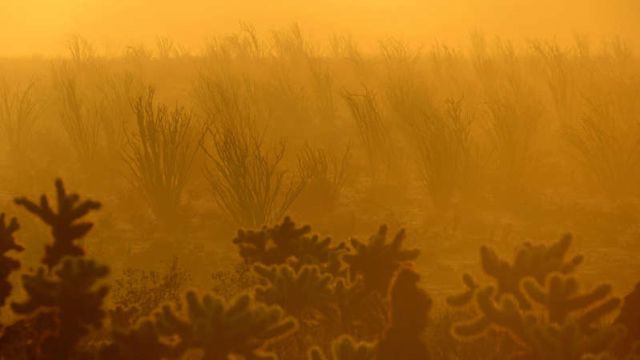Desert plants – famous for tolerance of torrid landscapes – are dying at an alarming rate due to the twin threats of even hotter weather and less rain, according to last research.
After analyzing more than three decades of satellite data, University of California, Irvine, scientists found a 37% decline in native vegetation across nearly 5,000 square miles of the Southern California Sonoran Desert, from the Mexican border north across Anza-Borrego Desert State Park to Palm Springs, California.
Some scientists, including the study's lead author, Stijn Hantson, had hoped that hardy desert plants would be able to survive rising temperatures and less rain, but the research definitively shows the opposite.
"They're already so badly beaten by drought or heat that they're at the brink of existence," said Hantson, a UC Irvine project researcher. Add slightly hotter weather and even less moisture, and they perish, with nothing able to grow and replace them.
"They are not somehow super adapted to be able to withstand the effects of climate change," said co-author James Randerson, a biogeochemist and UC Irvine professor.
The researchers were particularly surprised at the role played by higher heat due to human-caused climate change in driving the plant loss. Plants and trees on the dry side of nearby mountains saw a slower rate of decline – only 13% – likely due to slightly lower temperatures.
The team analyzed Landsat satellite data from 1984, when higher definition readings became available, through 2017. The satellite passes overhead every 16 days, and researchers used near-infrared and red wavelength readings from summer months, when only native shrubs and trees are visible, to track striking declines in overall plant life.
The new satellite-based work offers a big picture perspective that is also helpful for scientists who are chronicling specific species succumbing at ground level.
"Satellite or remote sensing technology has really revolutionized what we can study without setting foot on the ground," said Lynn Sweet, a University of California, Riverside, a conservation biologist who studies desert plants just to the north of the study area, who was not part of the paper. "Many changes in where plants occur, how dense they are, and their condition can be detected using the different wavelengths of light reflected and absorbed on the ground. This is a really neat application of this technology. This has of course ramifications across the food chain."
In a cascading series of impacts, pollinator insects that rely on the vegetation for food and water, lizards that eat the bugs and the larger animals that rely on the reptiles – including already endangered species – are struggling harder as a result of plant loss, she and Randerson said.

At sunrise, fog descends on an ocotillo forest in Anza-Borrego Desert in Southern California. © Sicco Rood / Steele/Burnand Anza-Borrego Desert Research Center
The work doesn't identify specific species that are dying but complements efforts by researchers who are examining ocotillo, creosote bush, yucca, mesquite and other Sonoran Desert plants.
"The study is valuable because it provides an overall view of plant biomass and how it is being impacted by climate change, which includes warmer temperatures, a decline in precipitation... and a doubling of long-term droughts lasting three or more years," said veteran desert ecologist James Cornett, who was not affiliated with the new work.
"Because it relies on satellite imagery, it cannot show which species of plant are being most impacted. That is where boots-on-the-ground fieldwork comes into play to show us exactly which plant species are in trouble."
Having both the groundwork and the sky viewpoint "doubles our confidence in saying that some very bad things are happening in our desert environment," Cornett said.
So far, 2021 is shaping up to be another year of extreme loss for fragile desert life, with below-average rainfall and record-breaking late-spring temperatures.
"They're going to get hit again," Stijn said. "They're pretty sensitive to these extremes."
By Janet Wilson, Palm Springs Desert Sun














